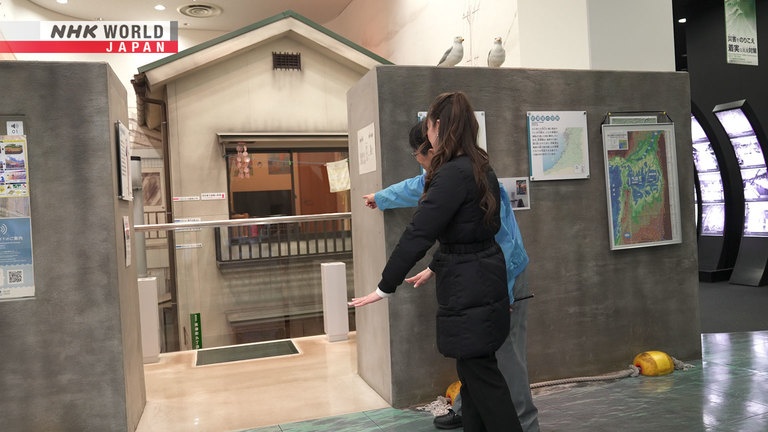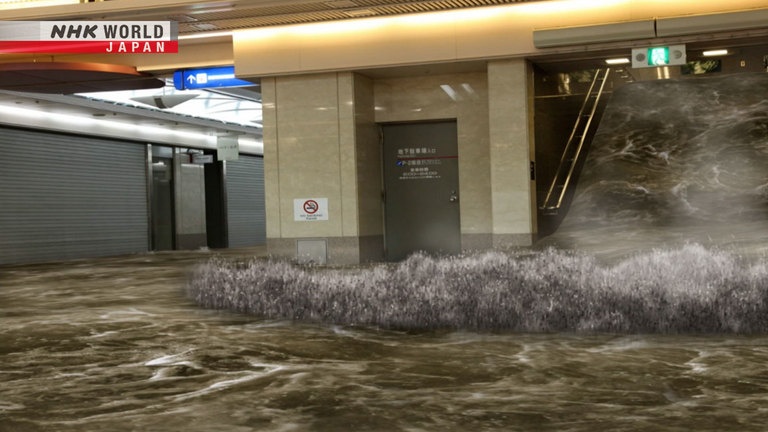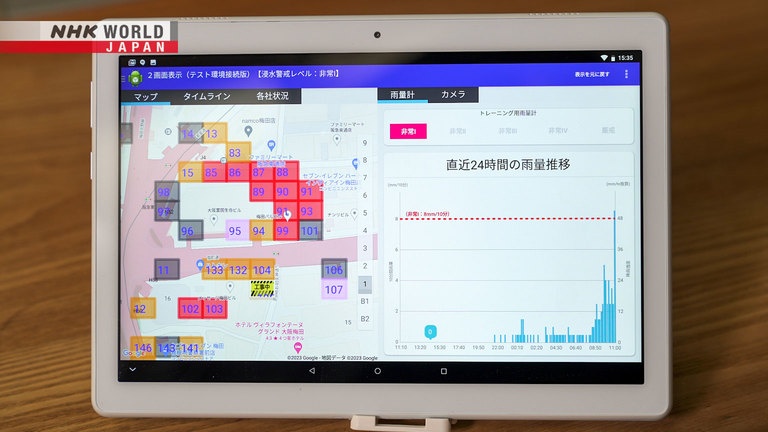#38 Osaka Metropolis
Osaka, a city that thrives on rivers, has faced countless flood damage. Find out the latest measures protecting the city from typhoons and heavy rain.




Transcript
Japan has a long history of natural disaster.
Now, the power of science is helping to overcome them.
BOSAI: Science that Can Save Your Life.
Osaka... it is one of the most prominent cities in western Japan.
It developed into a commercial district
thriving from the numerous rivers and waterways running through the heart of the city.
They've got everything from amusement spots to amazing budget-friendly foods,
attracting a large number of tourists from both in and outside of Japan.
However, this city of water has suffered countless flood damage.
It says here on this banner that
Osaka is below sea level.
Yes, "Osaka Below Sea Level."
It says here that it's sea level
where we're standing.
And if you look over there,
there's a 2-story house.
It's lower than sea level!
Much of the area around Osaka Bay is low-lying land.
The areas indicated in dark blue are below sea level.
They extend over an area of approximately 124 square kilometers.
That is why typhoons and torrential rain have led to many casualties.
Furthermore...
Oh, wow. That is a very high tsunami.
It's going toward the city.
It is said that there is a 70-80% probability for the massive Nankai Trough earthquake to strike within the next 30 years.
The tsunami generated by the event could cause large amounts of water to flow back into the rivers and flood the cities.
In Osaka, steps are being taken to protect the city from flooding using various technologies.
Today's episode is "BOSAI: Osaka Metropolis."
We'll find out about the latest efforts to prevent flood damage in Osaka, also known as the "city of water."
Our first stop was a facility that was designed to protect the city from floods.
This is the facility.
It's massive!
What exactly is it?
It's a floodgate, designed to close
when storm surges occur during typhoons.
It protects Osaka from flooding.
A storm surge is a phenomenon that occurs when typhoons or low-pressure systems develop.
A drop in atmospheric pressure causes the sea surface to be sucked upwards.
When that is combined with strong winds blowing seawater towards the coast, the sea level rises abnormally.
As a result, seawater can breach levees or flow back up the river and lead to flooding.
In the past, Japan has experienced a typhoon where over 5,000 people were reported dead or missing.
This massive floodgate was constructed to block water from the sea.
It stands at approximately 30 meters high and weighs 530 tons.
This is how the gate closes.
During an emergency, it closes in about 30 minutes.
Why does it have the unique arch shape?
There are many ships in Osaka.
This arch design allows large vessels
to pass through.
Also, we have a lot of earthquakes in Japan.
This unique design was adopted
for its earthquake resistance.
In Osaka city, there are 2 other floodgates similar to this.
Together, they are known as the "Three Major Floodgates."
The three major floodgates have played a significant role in the past.
In 2018, a powerful typhoon hit Japan, causing extensive damage with its fierce winds.
What was particularly threatening was the storm surge.
This is footage of Kansai International Airport, which was engulfed by seawater.
The storm surge caused seawater to enter the runway, rendering the airport inoperable.
In Osaka city, however, the three major floodgates worked effectively.
Here is footage from that event.
On the right side of the screen is Osaka Bay.
Despite the downstream water level rising by more than 5 meters,
the floodgate, standing at a height of more than 7 meters, efficiently blocked the storm surge.
The successful damage mitigation is estimated to have saved 17 trillion yen in financial losses.
In the 30 years working for the city,
I've never experienced a typhoon
like the one in 2018.
But closing the floodgates
helped protect the upstream areas.
They had prevented damage.
The three major floodgates aren't the only features protecting the city of Osaka.
This is a flood barrier.
It is typically constructed near coastlines.
When the risk of storm surges increases, the road is blocked and the barriers are put in place to prevent flooding.
Such barriers are installed in 570 locations throughout Osaka Prefecture.
And now...
There's construction underway.
Yes, it's the new floodgate.
A new floodgate?
The floodgates I introduced earlier
were built 50 years ago and are aging.
The new ones feature a rolling gate design,
different from the arch shape.
This is the conceptual design for the new floodgate.
The gate will open and close by moving up and down on rollers.
The time it takes for the gate to close will be reduced from the current 30 minutes down to 10 minutes,
allowing to respond quicker to the changing conditions.
Furthermore...
The new gate is designed to withstand
storm surges as well as tsunamis.
Unlike the current steel gate,
it will be made of stainless steel.
Using stainless steel enhances its durability.
It is also more resistant to rusting, particularly in these coastal areas,
making maintenance easier compared to the current gate.
The first of the 3 new floodgates is scheduled to be completed in 2031.
Today's episode is "BOSAI: Osaka Metropolis."
Some of the secrets to protecting the city from flooding can be found right beneath us.
Next, we headed for one of Osaka's most famous shopping districts beneath Umeda.
I'm going in.
It's actually quite wide.
The area spans approximately 100,000 square meters,
connecting various facilities such as shops and restaurants, railways, and department stores.
There are roughly 300 exits that connect to the ground level.
It is one of the largest underground shopping centers in Japan with as many as 22,000 people during peak times.
One of the concerns about this underground shopping district is the risk of flooding.
Water can flow in from the stairs
and cause internal flooding.
We worry about overflowing sewage water
entering the facility during torrential rain.
There is concern that water overflowing from sewers and rivers could flow into the underground district and cause serious damage.
To take steps, Umeda's underground district adopted a new system in 2016, the first of its kind in Japan.
We visited the expert who developed the system.
Professor Nobuhiko Nishio investigates the use of information technology in urban areas.
Umeda's underground district is a large area
with many commercial facilities.
When dealing with rain,
different areas must work together.
Otherwise, water will keep flowing in
regardless of individual efforts.
Everything is connected.
Yes. So this system was developed to
facilitate cooperation among different areas.
Each area has a disaster management center.
All personnel can install the app of the system in a tablet
and share the latest hazards, necessary measures, and the current status of their own actions in real time.
In developing the system, the first step involved categorizing the 300 exits
based on how high they were above the surface of the road.
The exits were then categorized into 4 groups based on the time when flooding could be expected.
For example, Group A, with the highest risk,
can expect flooding within 20 to 40 minutes from when it first starts raining,
while group B can expect flooding within 40 to 60 minutes.
If they experience heavy rainfall exceeding their criteria,
the system utilizes data from gauges and forecasts
to notify personnel at the disaster management centers what actions to take.
Following the notification, action is taken starting with Group A, where the risk of flooding is the highest.
The measures involve checking rainfall levels, making inspection rounds,
and putting up barriers to prevent water from entering the area.
This is the tablet.
Yes. This is what they use
at each disaster management center.
It's all you need.
We can check the situation in real time?
Exactly.
It's sunny today.
It hasn't rained today,
but let's check the rainfall gauge.
Zero at every point.
This is a map of the Umeda underground shopping district.
There are 5 camera icons.
Let's click here.
- This is right now?
- Yes. You can see it's sunny today.
Professor Nishio showed us a simulation of what would happen if there was heavy rain.
Oh, there's an alert.
What does it say?
Disaster level has changed.
This is level 1, so we have to go
inspect the exits indicated in red.
There are so many.
First, let's tap number 85 on the left.
Next, let's change the status.
Tap on "making rounds."
We're making the rounds now.
Okay. There's a little eye.
Number 85 is being inspected.
Disaster management personnel
in other areas can see
in real time that the status changed
to "making rounds."
And see that action is being taken.
This system proved to be useful during the massive typhoon in 2018.
We knew that heavy rain was coming
and that measures had to be taken.
Thanks to the swift actions by people
using our system, there was no flooding.
Osaka, the city of water.
Behind this glamorous city, various technologies are being used to protect our everyday lives from floods.
Did you know that Osaka will host the World Expo in 2025?
If you ever visit, you'll feel safe knowing that there are technologies hidden throughout the area to empower disaster resilience.